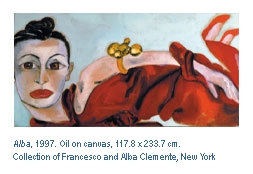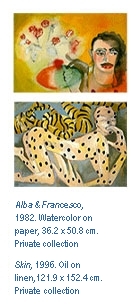


In 1980, at the 39th Venice Biennale, Francesco Clemente emerged before an international audience and won critical acclaim for his rich and complex visual imagery. His use of the figure and return to traditional, artisanal materials broke with the dematerialization of the art object that was prevalent in the art of the late 1960s and 1970s, and he went on to take a central role in the international revival of Expressionism in the 1980s.
Clemente moves fluidly across temporal and cultural boundaries, from the ancient Mediterranean to India and New York City. He draws omnivorously from diverse sources: Italian Renaissance illuminated manuscripts and frescoes, Indian miniature painting, Romanticism, Abstract Expressionism, and Pop Art. Alluding to the kaleidoscopic range and elusive nature of this pictorial universe, critic Edit deAk described Clemente as a "chameleon in a state of grace."
Born in Naples in 1952, Clemente moved to Rome in 1970 to study architecture. The '70s in Italy were marked by frequent student protests, massive labor strikes, outbreaks of urban terrorism, and sweeping social battles. Against the backdrop of these deep social, political, and economic upheavals, Clemente began to explore the medium of drawing. Influenced by the work of Joseph Beuys, Alighiero Boetti, Luigi Ontani, and Cy Twombly, he accumulated a reservoir of images that he would transform and reinvent throughout his career. Seeking alternative modes of aesthetic experience, Clemente made several extended trips to India between 1973 and 1978. During these visits, he continued to produce notational drawings and began to collaborate with Indian artisans on works such as Two Painters (1980) India's heterogeneous culture profoundly affected Clemente's artistic and intellectual sensibility, impressing upon him a model for the stylistic fragmentation that would characterize his oeuvre. In India, the artist found the freedom to work simultaneously with different subject matter and mediums, such as drawing, watercolor, fresco, oil painting, sculpture, and book illustration.

By 1978, Clemente's work commanded the attention of many artists and critics. The Italian art critic Achille Bonito Oliva grouped Clemente with other Italian figurative artists of his generation--notably Sandro Chia, Enzo Cucchi, Nicola de Maria, and Mimmo Paladino--under the banner of the Transavanguardia. Bonito Oliva defined the artists of the Transavanguardia as cultural nomads who roamed freely throughout history to weave together personal myth and public imagery. In the early 1980s, this uniquely Italian movement was assimilated into the international phenomenon known as Neo-Expressionism, or New Image Painting, and Clemente acquired the label of Neo-Expressionist with the exhibition of large-scale, gestural paintings such as Perseverance (1982) and The Fourteen Stations (1981-82), a cycle of twelve large canvases that reinterpret Christ's Passion with a dramatic layering of images reminiscent of Willem de Kooning's art. Despite its figurative qualities, however, Clemente's visual grammar exceeds the rhetoric of Neo-Expressionism, and his complex art has always resisted categorization.
Drawn to New York's wild cultural heterogeneity, Clemente and his family moved permanently to the city in 1981. He quickly integrated himself into a community of painters, graffiti artists, composers, musicians, filmmakers, poets, and critics, and collaborated with several of its members. He illuminated poems by Allen Ginsberg and created a group of paintings with Jean-Michel Basquiat and Andy Warhol. It was also around this time that a quality of lightness appeared in his work, exemplified by the whimsical line renderings and simple, airy composition of the series of watercolor portraits begun in 1982, such as Morton Feldman, Keith Haring, and Robert Mapplethorpe (ca. 1982-87).
The retrospective Clemente, organized by Deputy Director and Chief Curator Lisa Dennison, unites more than two hundred works in various mediums dating from the early '70s through the present. Extending the antihierarchical logic and open-ended spirit of his art, the exhibition is organized according to eight themes chosen by the artist. More poetic than categorical, these themes open several paths into Clemente's labyrinthine oeuvre and synthesize for the viewer a uniquely personal narrative of his work. I examines how Clemente's portraits and self-portraits constitute the self as a permeable entity whose borders shift in encounters with the Other. In the watercolor Alba & Francesco (1982), for example, the boundaries between the artist and his wife disappear as the two literally blend into one another. The works in Unborn evoke the paradoxical character of Clemente's art, suspended between the material and the immaterial, word and image, East and West, and--as in The Dark in Me (1988),

 whose terra-cotta
and gold coloration recalls Etruscan art--past and
present. Books, Palimpsests, Collaborations
examines Clemente's involvement with the literary
community, especially his book collaborations with poets.
Inspired by 12th- and 13th-century books that explicate
the spiritual importance of animals, Bestiary
reveals the artist's conviction in the equal importance
of all orders of existence, from the animal to the
mystical. Conversion to Her links the polymorphous
sexuality in Clemente's imagery to the idea of
metamorphosis. Rooms opens spaces for meditation
and features various frescoes as well as The Indigo
Room (1983-84) and The Fourteen Stations. In
Amulets and Prayers, signs, numbers, and
references to the elements and the senses that recur
throughout Clemente's work are treated as interwoven
systems imbued with personal significance. The sculptures
Sun, Moon, Mercury, and Saturn (1992), for
example, link the alchemical power of metals to celestial
bodies. Directly beneath Frank Lloyd Wright's domed
skylight, Sky employs the metaphor of the cosmos
to suggest how Clemente's ideas and images combine to
form a unique aesthetic constellation.
whose terra-cotta
and gold coloration recalls Etruscan art--past and
present. Books, Palimpsests, Collaborations
examines Clemente's involvement with the literary
community, especially his book collaborations with poets.
Inspired by 12th- and 13th-century books that explicate
the spiritual importance of animals, Bestiary
reveals the artist's conviction in the equal importance
of all orders of existence, from the animal to the
mystical. Conversion to Her links the polymorphous
sexuality in Clemente's imagery to the idea of
metamorphosis. Rooms opens spaces for meditation
and features various frescoes as well as The Indigo
Room (1983-84) and The Fourteen Stations. In
Amulets and Prayers, signs, numbers, and
references to the elements and the senses that recur
throughout Clemente's work are treated as interwoven
systems imbued with personal significance. The sculptures
Sun, Moon, Mercury, and Saturn (1992), for
example, link the alchemical power of metals to celestial
bodies. Directly beneath Frank Lloyd Wright's domed
skylight, Sky employs the metaphor of the cosmos
to suggest how Clemente's ideas and images combine to
form a unique aesthetic constellation.--Melanie Mariño, Curatorial Assistant
 is the sponsor
of this exhibition as part of its ongoing support of the
Solomon R. Guggenheim Foundation.
is the sponsor
of this exhibition as part of its ongoing support of the
Solomon R. Guggenheim Foundation.
Additional support provided by the National Endowment
for the Arts.